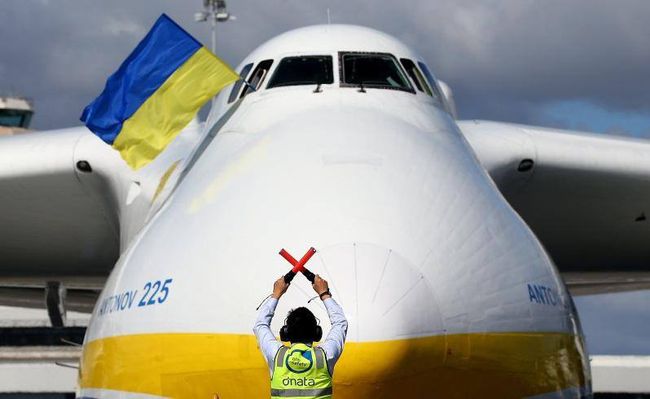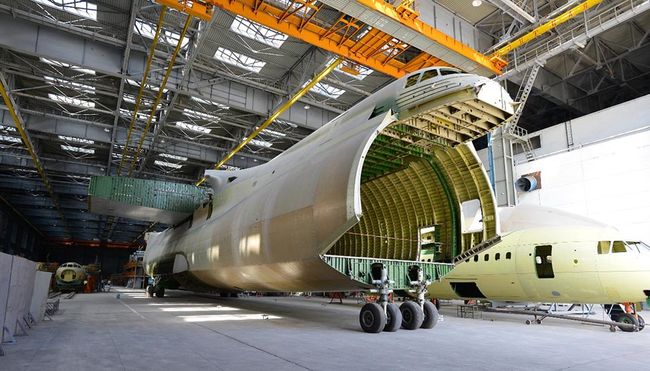Betrayal or victory?
How the destiny of Ukraine’s Mriya really changed in China
First of all, the An-225 Mriya (“Dream”) has not been sold. Ukroboronprom and the Antonov state-run enterprise are really negotiating with a Chinese investor the batch production of this strategic airlifter. Indeed, they discussed this on August 30 in Liuzhou with top councilors of this city and managers of the Airspace Industry Corporation of China. But, as a reliable source in Ukroboronprom told The Day, no specific contracts on sales or joint production were signed. The Chinese wanted (and still do) to buy the design documentation and we – to sell the second unfinished An-225 which has been gathering dust in an Antonov hangar for almost 30 years. That was the end of it. And, not to come home empty-handed, they signed a memorandum.
That the Antonov management is seeking a possibility to update the program of the An-225 batch production is not a novelty. Oleksandr Kotsiuba, then vice-president and now president of Antonov, revealed this earlier this year in an interview with Liga.net. He estimated the cost of this project at 3-4 billion dollars and said that a Chinese investor was showing certain interest in it. But Kotsiuba doubted that this company could cope with such an expensive and complicated project. “There is certain interest on the part of China. For them, it is quite a realistic sum. But, so far, it is at a stage of discussion. The Mriya is interesting not only as a unique commercial carrier. An aircraft like this will improve the image of any country. But this amount is too large for one company. We see it as an interstate project of sorts,” Kotsiuba said then. In principle, negotiations in Liuzhou have brought nothing new, our source claims. And, but for the thirst of journalists for sensations, this fact may have even gone unnoticed. First, Chinese journalists rushed to report that the world-famous Mriya was now their country’s property. Their Russian colleagues picked up this information. As for the Ukrainian media space, the information was much closer to the truth. The Ukrainian media reported that the Chinese had bought the right to put the Mriya into batch production. The Antovov press service soon denied this information, too, explaining that the Ukrainian side signed on August 30 in Liuzhou an agreement on cooperation with the Chinese (to be more exact, Hongkongite) company Airspace Industry Corporation of China (not to be confused with the Chinese monopolist Aviation Industry Corporation of China, AVIC) and the city’s administration. “The two sides thereby expressed an intention of long-term cooperation, which envisions, at the first stage, the construction of a second upgraded aircraft An-225 Mriya by Antonov and the delivery of it to the company AICC, and, at the second stage, the joint batch production of the An-225 in China under the Antonov license,” the press service said. Antonov stressed that a separate contract would be signed for each stage. The details will be known immediately after the return of the delegation from China. But, as the Antonov president Kotsiuba emphasized, “there is no question of transferring ownership rights and know-how, or selling the now existing and flying Mriya.”

THE ANTONOV PLANT HAS BEEN KEEPING, FOR MORE THAN 30 YEARS, THE SECOND, UNFINISHED, AIRFRAME OF THE AN-225 MRIYA PLANE WHICH THE MANAGEMENT PLANS TO FINISH AT FOREIGN EXPENSE / Photo courtesy of the Antonov state-run enterprise
The Mriya is a pride of the Ukrainian aviation industry. Manufactured in the late 1980s, it still remains the world’s largest and powerful cargo aircraft. Since its maiden flight in 1988, the plane has performed missions under five contracts that were beneficial to this country in terms of both image and finances. The Mriya made its first commercial flight on January 31, 2002, from Stuttgart to the Sultanate of Oman, carrying 187.5 tons of foodstuffs for the US military stationed there. Since then, the An-225, as well as the An-124 Ruslan, has been a “workhorse” in the fleet of Antonov Airlines planes thanks to its ability to carry oversized items that could not have been airlifted before (locomotives, 150-ton generators, etc.). Being able to rapidly deliver large-size cargo to those who have suffered from natural disasters, the airplane acquired the reputation of a valuable helper to humanitarian organizations. But, in spite of the Mriya’s uniqueness and power, Ukraine has had no orders so far to manufacture it. This plane is too expensive because of its rather narrow specialization – it is rational to use the An-225 only when it is necessary to carry large-size or oversized cargos at a long distance.
Why do the Chinese need the An-225? Bohdan Dolintse, an aviation market expert, suggests in a comment to The Day that the investor wants to monopolize the air launch to orbit technology. “China is already trying out the air launch technology. They launch small flying vehicles into outer space from the locally-produced airplanes. Maybe, they need the Mriya as a midair launch pad,” the expert says. At least, he says, there is more logic in this than in the presumption that China will use the plane as a cargo carrier. It will be recalled that the An-225 was made, first of all, in the interests of the Soviet space program to transport such cargos as Buran space shuttles and components of the Energia rocket system.
According to Dolintse, if the Ukrainian side manages to convince the Airspace Industry Corporation of China to invest money in the completion of the second Mriya, this will be an unequivocal victory for Ukrainian aviation, for we cannot do this on our own due to lack of funds. “And I am afraid that when we do have this money, the An-225 will no longer be a sought-after aircraft.” Now, Dolintse stresses, we have a chance to earn the money which we can invest in the further active development of such aircraft as the An-178, the An-70, and others. But we are really running a risk in this cooperation. As there is no concrete information about the contract, it is quite likely that the project will be implemented partially: the Chinese will get what they needed – some technological and design-related information – in order to carry out their own projects and then cut short cooperation with the Ukrainian partner. “I don’t know whether or not the memorandum takes this risk into account because nobody has seen this document yet,” the expert stresses.
Viktor Halasiuk, chair of the Parliamentary Committee for Industrial Policies and Entrepreneurship, has already requested the Antonov president to explain what was signed in China. He pointed out in a comment to The Day that, according to his information, the earlier media reports were not true, but, to finally clarify the situation, he made an interpellation. “Undoubtedly, the Ukrainian aviation industry has no good prospects without international cooperation. But this does not mean that we should make the concessions which will make us unnecessary to our foreign partners 5-10 years later. So this is a very subtle matter. The key technologies and production must remain in Ukraine,” the MP emphasized.
The Ukroboronprom management has assured The Day that “we hold back and do not sell our technologies, particularly the classified ones.” “Whenever the governments of two states conclude a bilateral agreement, they pledge to ensure secrecy. We also do so. All the technologies that Ukraine needs are safeguarded. If you recall the aircraft Variag story, I must say that we did not need the ship any longer – moreover, we were not going to build new ones. So it was decided to sell it,” says Oleksandr Stetsenko, deputy director general of Ukroboronprom. “Today, Deutz AG (Germany) has sold the engine production certificate and established a complete cycle of production in China. And I see nothing terrible in this. I want to say clearly that the position of the Defense Ministry is as follows: secret military technologies are not subject to sale.”
Newspaper output №:
№49, (2016)Section
Economy





